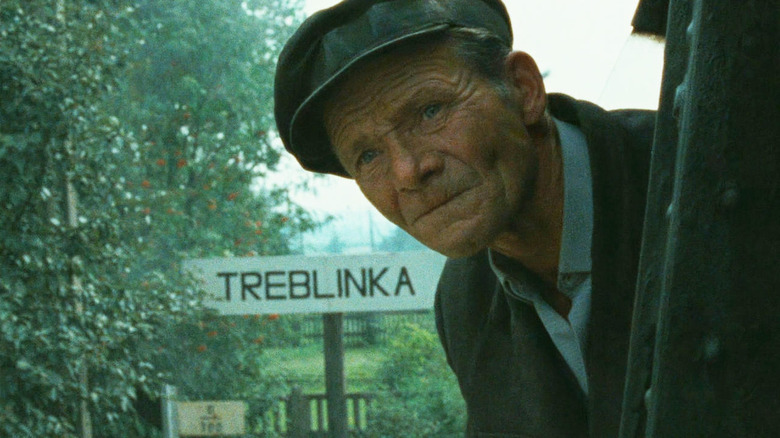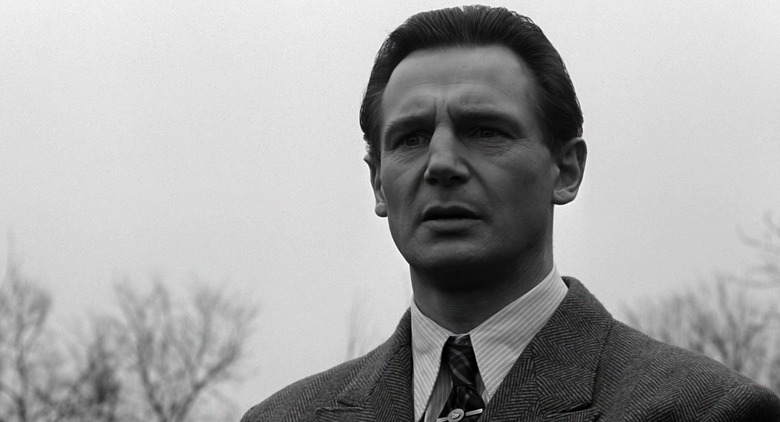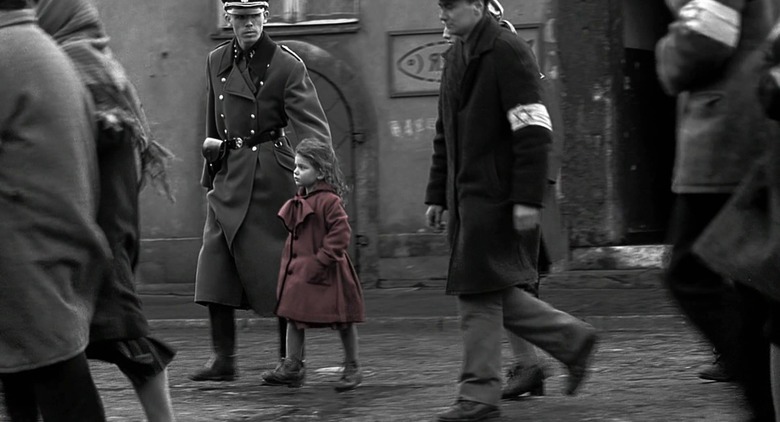'Schindler's List' And 'Shoah': How Two Of The 20th Century's Greatest Films Illuminate Each Other
Two of the 20th century's greatest films are bound together by the same historical tragedy. When it arrived in theaters in mid-December 1993 — just six months after his summer blockbuster, Jurassic Park — critics and audiences alike embraced Steven Spielberg's Schindler's List as a masterpiece. More than just an awards season drama, the film provided what's been called a "first foundational encounter with the Holocaust" for a whole generation of viewers. It soon emerged as the crowning achievement in Spielberg's career, earning him his first Best Director Oscar and his only Best Picture Oscar. In 1998, a mere half-decade after its release, Schindler's List placed in the top ten on the American Film Institute's list of the 100 greatest American movies of all time.
The movie had its detractors, however. Not everyone was enamored of Spielberg's dramatic approach to the weighty, real-life subject matter. One of the most vocal critics was Claude Lanzmann, a French filmmaker known for his own landmark Holocaust documentary, Shoah. Released in 1985, Shoah helped inspire the pseudo-documentary look of Schindler's List. In 2012, it was this film, not Spielberg's, that showed up in the results of the British Film Institute's once-a-decade poll of the 50 greatest films of all time. Yet when Shoah was commemorating its own 25th anniversary back in 2010, Lanzmann lamented to The New York Times that his film had "disappeared from the American scene."
Earlier this year, Lanzmann passed away, and now all eyes are on Schindler's List again as we recognize the quarter century that has passed since its release. Recent world events have made both of these films more relevant than ever, and rather than be at odds, Schindler's List and Shoah stand as necessary companion pieces in the preservation of Holocaust awareness.
The Sobering Testimony of Shoah
While Schindler's List is based on a true story, it is very much a dramatization of that story, as opposed to a straight documentation. This makes it intrinsically different from Shoah, which relies solely on interviews, the living testimony of real Holocaust survivors. Yet the way Schindler's List ends, with survivors and the actors who portrayed them visiting Schindler's grave, it could almost flow directly into Shoah's interviews. The two movies might be ideally paired as a double feature, with each film illuminating different aspects of the other.
Eschewing the standard format of other historical documentaries like Ken Burns and Lynn Novick's recent The Vietnam War, Shoah does not even make use of old newsreels. Interspersed among the talking survivor heads, the only location footage we see is that of actual sites in Poland as they existed years after World War II.
Roger Ebert described Shoah as "an act of witness," and in a way, it does put the viewer in the position of a juror, sitting in on a trial (whereas Schindler's List makes the viewer an audience member, watching a skillful reenactment). Playing interviewer, Lanzmann attempts to reconstitute history from oral accounts and the examination of documents like a train schedule to extermination camps.
In an era where podcasts and Netflix documentary series such as Serial and Making a Murderer have enjoyed great success packaging true crime as entertainment, Shoah is ripe for rediscovery as something more than that. It takes a similar investigative approach to one of the most heinous crimes ever perpetrated against humanity. It's less sensationalistic, however, because in this case, we know who the murderers are, and Lanzmann is not interested in parceling out cliffhangers or asking big profound questions about the why of it all (as if any justifiable meaning could be extracted from a crime so senseless).
Soul-searching is left to the viewer, not some chatty narrator. Lanzmann is more concerned with forming a mosaic of nitty-gritty details to illustrate the precise reality of how the Holocaust happened.
In the past, one hurdle that might have impeded viewership with Shoah is its epic length. If you thought Schindler's List was long at three hours and fifteen minutes, Shoah clocks in at over nine hours. While the BBC has broken it up into two 4.5-hour episodes for broadcast purposes before, it generally is regarded as a movie and hasn't stirred debate about feature-film length the way the documentary O.J. Made in America did a couple years ago. The trend of binge-viewing nowadays makes it a less daunting watch, but the fact is, Shoah does make a significant time demand of the viewer and people with short attention spans might not have the patience to commit to it.
Those who do commit to it and who are coming at it from a place where Schindler's List is their primary cinematic reference for the Holocaust will find that Shoah immediately has a sobering effect. It snaps the viewer out of any Hollywood reveries and anchors him or her to cold, hard history. The testimonies given elicit a mixture of disbelief, pity, and outrage, the kind of righteous indignation that comes from being confronted by the knowledge that an institutionalized evil really happened.
That evil was sanctioned and enabled not by cartoon villains but by people who simply adjusted their normal mode of living to facilitate an atrocity. As distant as the 1940s might seem, we're only decades removed from a time when banal, bureaucratic actions led to the unthinkable in seemingly civilized countries. The image in Schindler's List of a road paved with gravestones is an apt visual metaphor for how man's inhumanity toward man solidifies step by step.
One of the most astute observations in Shoah comes from a historian who notes, "The key to the entire [Nazi] operation from a psychological standpoint was to never utter the words that would be appropriate to the action being taken." This is how the Nazis carried out their "Final Solution of the Jewish Question," which itself was a code name for the systematic genocide that would claim two-thirds of Europe's Jewish population before World War II was over. In addition to Jewish people, of course, Romani people, ethnic Poles, homosexuals, and other groups deemed sub-human by the Nazis suffered their own mass killings.
In Schindler's List, when German businessman Oskar Schindler, played by Liam Neeson, first sits down with Nazi SS officer Amon Goeth, played by Ralph Fiennes, we notably hear Goeth venting about the paperwork and permits required to set up a "sub-camp" where Schindler can utilize Jews as factory workers. For him, the business of the Holocaust is a job like any other. Everyone has his or her part to play.
The job of the real-life train worker on the Shoah movie poster was to bring victims to the extermination camp at Treblinka. As he was leading the convoy of train cars into the camp, he would signal to the other cars by drawing his finger across his throat in a slashing motion.
Schindler's List remixes the reality of this into a movie scene. When the train full of female workers in Schindler's factory gets rerouted to Auschwitz, one of the women on board looks out the window to see a Polish child making the same ominous hand gesture.
Criticisms of Schindler's List
It's this kind of creative license-taking, the changing of details, the shifting of focus to suit the needs of a drama-fed audience, that was so anathema to Lanzmann as a documentarian. In his criticisms of Spielberg's film, he expressed disapproval not just of it, but of any sort of Holocaust reenactments or dramatizations whatsoever. Believing such storytelling to be exploitative, he even went so far as to label Schindler's List a "kitschy melodrama."
Surprising as it may seem for a movie that received such widespread acclaim, that's an opinion shared by others, not just Lanzmann. The online Jewish magazine Tablet ranked Schindler's List dead last on its list of the 100 greatest Jewish films, with a blurb that called it "astoundingly stupid." (Another surprising result, given its own initial controversy within the Jewish community, was that Spielberg's Munich ranked much higher on that list). A follow-up article on the same website argued that Schindler's List was "both a moral and an aesthetic disaster, an embodiment of much that is wrong with American-Jewish life."
The abject horror of the Holocaust may hit too close to home for some people of Jewish heritage to embrace any Hollywoodized version of events, particularly one with a sentimental, humanistic streak like Schindler's List. Having said that, many criticisms of Spielberg's film seem to stem from intellectuals, deep thinkers with a cache of knowledge that goes beyond the level of awareness general audiences would have. That's not to devalue those criticisms; it's just to say that the movie perhaps purposely appeals to the emotions over the intellect.
Having once sat in on a graduate-level Studies in Film course that centered on depictions of the Holocaust, I can say from personal experience that it's eye-opening to hear how some college academics view Schindler's List. When I was younger, it never occurred to me that the movie was anything other than a masterpiece, but that course drew my attention to things like how the music manipulates the audience. In the end, it made me much more conscious of the mechanics behind Spielberg's approach.
In Schindler's List, the full-tilt madness of the liquidation of the ghetto doesn't come until about an hour into the movie. Prior to that, there's a good deal of setup, much of it propelled by John Williams' score, which gives scenes that might otherwise be dry an ongoing momentum. There's no denying that Schindler's List engages the viewer in a more kinetic manner than Shoah. It's a film where Spielberg, the greatest popular filmmaker of his generation, brought to bear his full creative prowess on the most powerful subject imaginable.
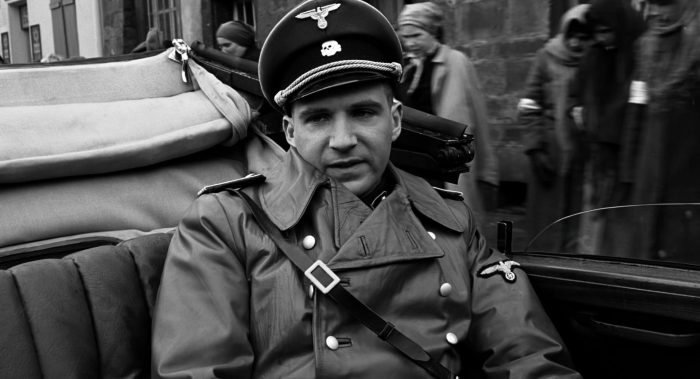
In any examination of history, or an old film, or an old historical film, there's a danger of applying one's own anachronistic, revisionist standards to a chronicle that is, fundamentally, of a different time. It's the kind of thing where you're liable to hear modern analysts talk about the Jewish characters in Schindler's List not having enough "agency"—even though the film's whole narrative necessarily revolves around them being stripped of their agency.
Quentin Tarantino's Inglourious Basterds subverts these criticisms. It's given a free pass, but it's also a work of Hitler-destroying alternate history. Schindler's List draws from the messier, less appealing truth of people rendered passive and powerless, made to run naked in circles and appraised for their health and usefulness like animals.
Characters like Ben Kingsley's Itzhak Stern or Jonathan Sagall's Poldek Pfefferberg do exercise agency, acting of their own accord to save lives, including their own. Pfefferrberg is the character who escapes into the sewer during the liquidation of the ghetto. He's based on the real Holocaust survivor who inspired the Schindler's List novel and was instrumental in "carrying the story" to Spielberg (or at least that's how Spielberg described it when he made Pfefferrberg the very first name he recognized in his Oscar acceptance speech).
Schindler's List is rooted in fictionalized fact, but as it provides its back-door history lesson, the issue with it as a teaching tool seems to be that it focuses on an extraordinary figure and an extraordinary survival tale. The Schindlerjuden, or Schindler's Jews, were really the exception to the norm. Most Holocaust victims were not so lucky.
Despite the smokestacks we see spewing ashes on screen, the sheer totality of people who did not evade the gas chamber and, in fact, died in Auschwitz is something the uneducated viewer might not be able to fully appreciate from watching Schindler's List alone. The impression or intimation of horror is there, but it's a fake-out. To get a fuller measure of what happened, you'd need to watch Shoah.
It's true that Schindler, Spielberg's decidedly non-Jewish hero, is also a less-than-ideal protagonist in some ways. For much of the movie, he's an unrepentant womanizer and war profiteer. Yet even though he's German, his business ambition, his ability to put on his best face and work a room to achieve the desired end, seems steeped in something like the American dream. In the 21st century, he's the perfect surrogate for the average self-interested viewer with no familial or religious connection to the Holocaust.
Schindler's List as an Empathy Machine
Drama is a distillation of life. It inhabits a hyper-reality of the imagination where emotions are heightened and events play out in a controlled, compact fashion. The scene in Schindler's List, for example, where Schindler implants the notion of pardoning-as-power in Goeth's head is immediately followed by three distinct encounters where Goeth tries to play emperor and dispense pardons to massage his own ego. It's a textbook example of the way that most mainstream cinematic storytelling works. Unlike life, with all its untidy, intersecting subplots, there's a logical progression of scenes that communicate a specific point.
In this way, the realm of fiction and dramatization can sometimes, despite its essential artifice, speak to a higher truth. When he was awarded a star on the Hollywood Walk of Fame, the aforementioned Roger Ebert said, "Movies are the most powerful empathy machine in all the arts." What gives Schindler's List such undeniable potency is its ability to arouse empathy — not mere sympathy, but profound empathy — in the viewer.
This a movie that hijacks the entertainment urge, drawing viewers into a story — letting them escape from their own lives momentarily — all the while raising awareness of a dire moment in history that shouldn't be forgotten, lest it happened again. The aim of Schindler's List is nothing less than to put the viewer in the shoes of people who were led off to the gas chamber and concentration camps.
It's one thing to hear and imagine the horror of that; it's another thing entirely to see it unfold in crisp black-and-white. Images like the wheelbarrowing of the little girl in the red coat, and Goeth's random sniping of people from his balcony, sear themselves into one's brain. We survive the vicarious experience, just as Schindler's Jews survived the real one, but we come away from it changed, unable to forget the enormity of what we saw.
Spielberg himself was never the same after Schindler's List. Since 1993, even his more spectacle-driven films like Minority Report and War of the Worlds have been characterized by a more somber look and feel, thanks in no small part to Janusz Kaminski's cinematography. It was only after Schindler's List, a more personal film where Spielberg was dealing with his own heritage and the burden of history, that the muse that drives him seemed to change, once and for all. He reportedly even considered retiring as a director after Schindler's List.
Spielberg's films post-1993 still evince trace sentimentalism, but there's also more cynicism when it comes to human nature and how things turn out (an example of this ... spoiler alert ... would be the ending of Bridge of Spies, which resolves the hug-or-back-seat setup by placing Mark Rylance's character firmly in the back seat.)
In addition to transforming Spielberg's career, Schindler's List also heralded the arrival of two great actors. Kingsley was already known for playing Gandhi, but before Neeson went through his mentor or action star phase, or before Fiennes played Lord Voldemort in the Harry Potter movies, they first embodied twin pillars of good and evil in this film.
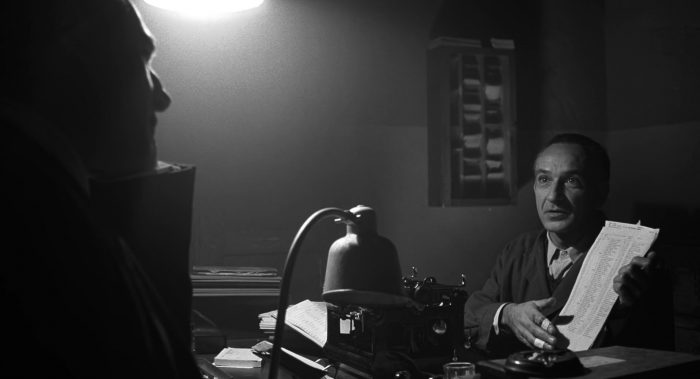 World War II was the defining event of the twentieth century. It's a harrowing chapter in recent history, and as such, it comes with a built-in pathos. If handled the wrong way, the subject matter of the Holocaust could (and in other movies, has been) exploitative. You could certainly accuse Spielberg of using manipulative moviemaking techniques, but the real question is, to what end does he employ those techniques? Is Schindler's List a hollow facsimile, straining at redemptive relevance, or is it a drama with true purpose?
World War II was the defining event of the twentieth century. It's a harrowing chapter in recent history, and as such, it comes with a built-in pathos. If handled the wrong way, the subject matter of the Holocaust could (and in other movies, has been) exploitative. You could certainly accuse Spielberg of using manipulative moviemaking techniques, but the real question is, to what end does he employ those techniques? Is Schindler's List a hollow facsimile, straining at redemptive relevance, or is it a drama with true purpose?
By appealing to the viewer's emotions through drama, Spielberg's film is able to elicit a commonality or kinsmanship of experience, one that transcends the limitations of personal experience. The controversial shower scene is a miniature impression of survival: we feel the sense of peril and the great sense of relief when women who think they are about to be gassed receive the spray of water instead. It's the same when Goeth leads the hinge-making rabbi outside the factory, has him kneel down, and holds a gun to his head, only to find that the gun is not working.
Like Lanzmann, Stanley Kubrick had a quote where he was critical of Schindler's List, saying, "Think that's about the Holocaust? That was about success, wasn't it? The Holocaust is about 6 million people who get killed. Schindler's List is about 600 who don't."
The Schindlerjuden actually numbered over a thousand, and as noted at the end of the movie, their descendants numbered thousands more. Still, what Kubrick said rings true, up to a point; but perhaps we should take that further and say that Schindler's List is about the living, full stop. As the movie's tagline puts it, "The list is life."
This film is about the survivors, the lucky ones, yes, but it's also about the audience, all the people who are alive right now, losing touch with history. An in-depth CNN report recently showed that anti-semitism was on the rise in Europe again, with a startling number of people being ignorant of Holocaust history altogether. In the wake of the worst anti-semitic attack in U.S. history at a Pittsburgh synagogue this October, Schindler's List and Shoah seem especially relevant to what is going on in the world right now.
Holocaust denial is a real thing, and if there's one thing history has shown, it's that the past is quickly forgotten and history repeats itself all too soon. As the World War II generation dies off, these movies are two vital artifacts that we have to keep the memory of what happened alive.
After twenty-five years, the power of Schindler's List has not diminished. It and Shoah are easily two of the most important films of the twentieth century. Both movies should be required viewing for cinephiles, students of history, and anyone alive in 2018 who's still human.

